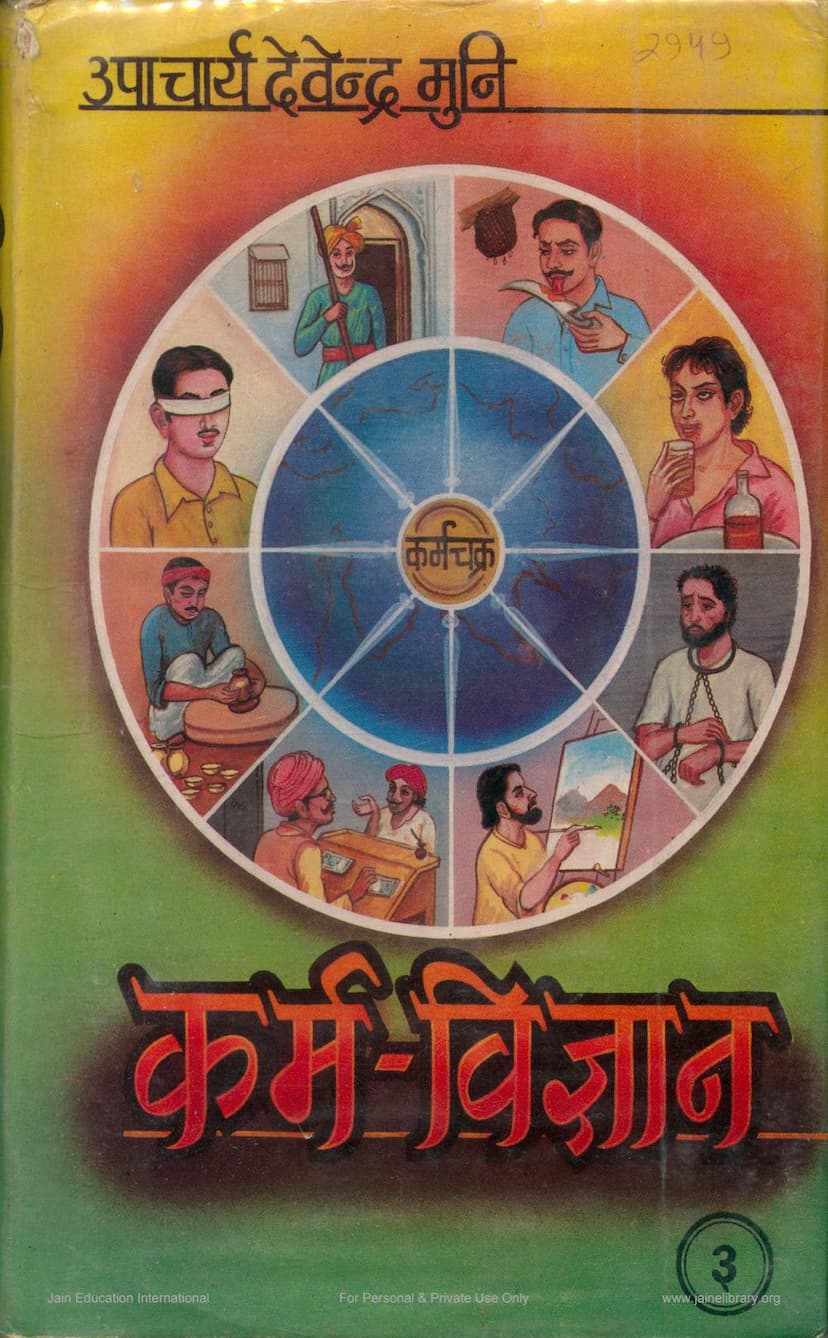Karm Vignan Part 03
Added to library: September 2, 2025

Summary
This is a comprehensive summary of "Karm Vigyan Part 03" by Devendramuni, based on the provided text:
Book Title: Karm Vigyan Part 03 (कर्म विज्ञान तृतीय भाग) Author: Upacharya Devendramuni (उपाचार्य देवेन्द्र मुनि) Publisher: Shri Tarak Guru Jain Granthalay, Udaipur Catalog Link: https://jainqq.org/explore/004244/1
This third volume of "Karm Vigyan" is a detailed exploration of the Jain doctrine of karma, specifically focusing on the concepts of Āsrava (आस्रव) and Saṃvara (संवर). It aims to simplify and present the profound spiritual and philosophical insights of Lord Mahavir on these subjects in an accessible manner.
Core Concepts Discussed:
-
Āsrava (आस्रव): This volume delves into the nature of āsrava, which is described as the inflow or attraction of karmic particles towards the soul. It is the source or gateway through which karmas enter the soul, much like water flowing into a lake through various channels.
- Āsrava as the Cause of Samsara: Āsrava is identified as the root cause of the cycle of birth and death (saṃsāra).
- Āsrava and the Soul's Nature: It explains how āsrava obscures the soul's inherent pure and blissful nature, akin to how clouds hide the sun.
- Types and Sources of Āsrava: The text details the various causes and channels (dwāras) of āsrava, primarily stemming from the activities of mind, speech, and body (yoga), influenced by passions (kaṣāya), attachment (rāga), aversion (dveṣa), delusion (moha), and ignorance (mithyātva). The text elaborates on the five primary āsrava gateways: mithyātva (false belief), avirati (non-restraint), pramāda (carelessness), kaṣāya (passions), and yoga (activities of mind, speech, body).
- The Role of Intent: It emphasizes that the āsrava is not solely determined by the action itself but also by the intention, mental state, and underlying passions associated with the action.
- Distinction between Āsrava and Bandha: While āsrava is the inflow of karmas, bandha (bondage) is the actual clinging or fusion of these karmas to the soul.
- Āsrava's Produce: The text explains how āsrava leads to the manifestation of various karmic consequences, influencing one's experiences of happiness and suffering. It highlights that āsrava can be both beneficial (puṇya) and detrimental (pāpa), depending on the nature of the activities and intentions.
- Āsrava and Other Philosophies: The text briefly touches upon how other Indian philosophical schools (Buddhism, Nyaya-Vaisheshika, Samkhya-Yoga, Mimamsa, Vedanta) perceive karma and its causes, often drawing parallels and distinctions with the Jain perspective.
-
Saṃvara (संवर): This volume meticulously explains saṃvara as the cessation or stoppage of āsrava. It is the process of blocking the inflow of new karmas and preventing further bondage.
- Saṃvara as the Path to Moksha: Saṃvara is presented as the essential path leading to liberation (moksha).
- Means of Saṃvara: The text details the various means and practices through which saṃvara is achieved, including:
- Self-control: Restraining the senses, mind, speech, and body.
- Austerities (tapas): Various forms of self-discipline and hardship.
- Mindfulness and Vigilance (samiti and gupti): Careful conduct in actions, speech, and thought.
- Right Faith (samyaktva): Correct understanding of reality and the soul's true nature.
- Non-attachment (vairāgya): Detachment from worldly pleasures and worldly things.
- Absence of Passions (akaṣāya): Overcoming anger, pride, deceit, and greed.
- Cessation of Delusion (mithyātva): Eradicating false beliefs.
- Equanimity (sama): Maintaining a balanced state of mind.
- The Analogy of the Dam: Saṃvara is likened to a dam built to control the flow of water from a river, thus preventing a flood. Similarly, saṃvara acts as a barrier against the influx of karmas.
- Types of Saṃvara: The text explains various aspects and practices contributing to saṃvara, such as controlling the senses (indriya-saṃvara), speech (vachan-saṃvara), body (kaya-saṃvara), mind (manas-saṃvara), and vital energies (prāṇa-saṃvara). It discusses the importance of mental discipline, control over speech, and careful bodily actions.
Key Themes and Emphases:
- Causality of Karma: The book underscores the principle of cause and effect in karma, explaining how actions (kriyā), influenced by intentions and passions, create karmic imprints (saṃskāra) that shape an individual's destiny.
- The Goal of Liberation: The ultimate aim of understanding āsrava and practicing saṃvara is to break free from the cycle of saṃsāra and achieve liberation (moksha).
- Balance between Spirituality and Practicality: While delving into deep spiritual concepts, the text also draws from everyday examples and analogies to make the teachings relatable.
- The Author's Style: The book is noted for its clear, logical, and scientific approach to discussing these profound topics, integrating scriptural authority (āgamic) with rational reasoning.
- Contribution of Supporters: The publisher expresses gratitude to Dr. Champalal Desarda for his significant financial contribution, highlighting his literary taste and devotion to the gurus.
Structure of the Volume:
This third part focuses on Āsrava and Saṃvara. It is divided into sections that systematically break down these complex topics, including:
- The nature and types of āsrava.
- The producers and catalysts of the "fire of āsrava."
- The five āsrava gateways.
- The role of yoga (mind, speech, body activities) in āsrava.
- The role of puṇya (merit) and pāpa (demerit) as forms of āsrava.
- The analysis of āsrava as the path to saṃsāra and saṃvara as the path to moksha.
- Detailed discussions on kaya-saṃvara, vachan-saṃvara, indriya-saṃvara, manas-saṃvara, and prāṇa-saṃvara.
In essence, "Karm Vigyan Part 03" serves as a guide to understanding the mechanics of karmic influx (āsrava) and the practical methods for its cessation (saṃvara), presented through the lens of Jain philosophy and spiritual practice.